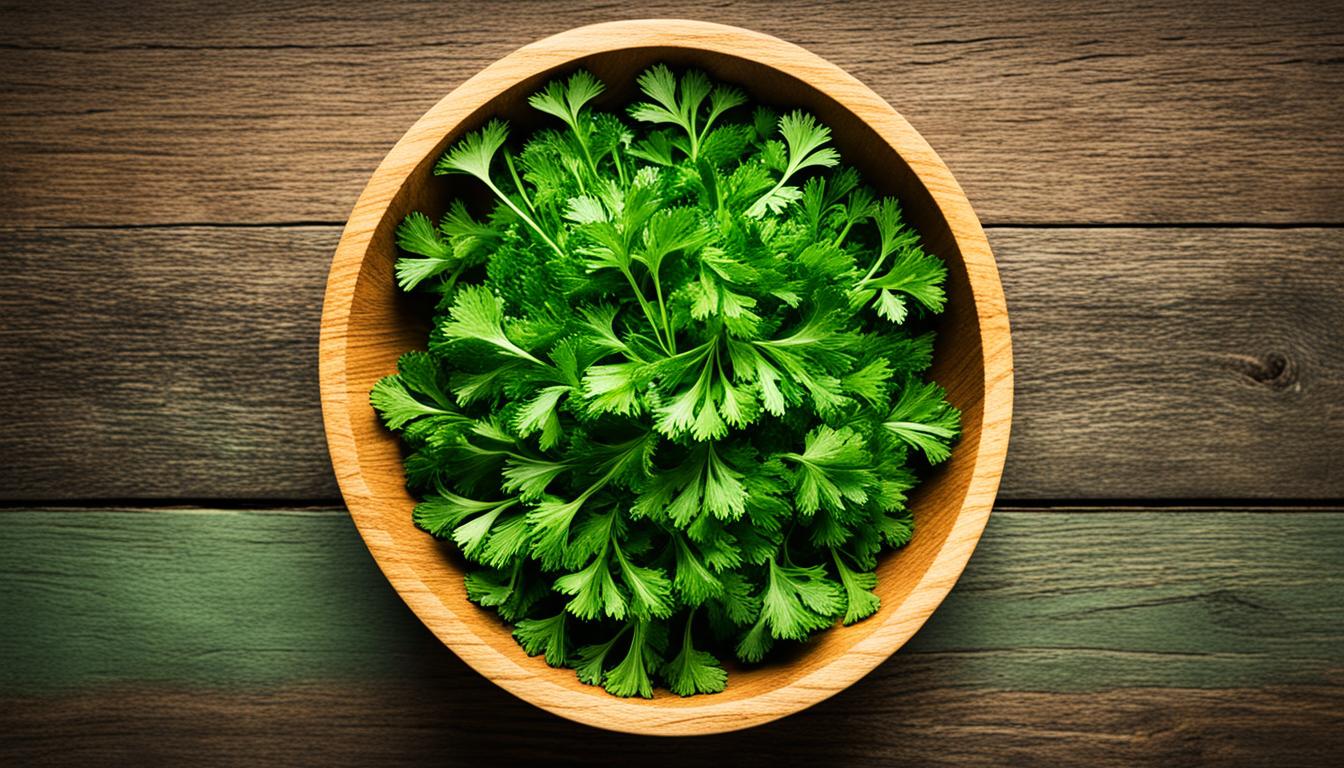Parsley is a powerful herb in the kitchen. It belongs to the Apiaceae family and is used in many cuisines. This herb is full of health benefits and can make many dishes taste better.
This article will cover the different types of parsley. We’ll talk about how to grow and use it. You’ll learn about its nutritional value and how it can make meals special. Parsley adds a fresh, herb-like taste to salads and sauces.
If you love cooking or want to try new things, this guide is for you. Let’s explore the many uses and health perks of parsley together. Discover how this simple herb can make your cooking better.
The Overlooked Powerhouse of Herbs
Parsley is often seen as just a garnish, but it’s so much more. It’s packed with nutrients and can make any dish taste better. This green herb is a powerhouse in the kitchen.
Exploring Parsley’s Versatility and Nutrient Profile
Parsley is great in many dishes, from salads to sauces. Its taste is fresh and herb-like, perfect with many foods. It adds a special flavor to your meals.
Parsley is also full of vitamins and minerals. It’s a top source of vitamin K, important for blood clotting and bones. Plus, it has vitamin C, A, and folate, and antioxidants like apigenin and luteolin.
| Nutrient | Amount per 1 cup (30g) of fresh parsley |
|---|---|
| Vitamin K | 547% of the Daily Value |
| Vitamin C | 53% of the Daily Value |
| Vitamin A | 18% of the Daily Value |
| Folate | 11% of the Daily Value |
Parsley is a true culinary powerhouse with its nutrients and versatility. It’s time to appreciate its value in the kitchen.
Types of Parsley: Curly, Flat, and Root
Parsley is more than just a simple herb. It comes in three main types, each with its own special traits. Let’s look at the different types of parsley and how they can make your cooking better.
Curly Parsley
Curly parsley, also known as French parsley, is the most well-known type. It has a delicate look and a mild, slightly peppery taste. People often use it as a garnish to add freshness and color to dishes. Its frilly leaves are great for decorating plates and making your food look nice.
Flat-Leaf Parsley
Flat-leaf parsley, also called Italian parsley, tastes bolder than curly parsley. It has flat, broad leaves that chefs and home cooks love. This type is great for cooking, adding its unique flavor to many dishes like sauces, soups, salads, and marinades.
Parsley Root
The parsley root is also edible and can be a tasty addition to your meals. It looks like a thick, white carrot and tastes slightly sweet and nutty. You can roast, sauté, or add it to stews and braises for a unique flavor.
Knowing about these different types of parsley helps you pick the right one for your cooking. Whether you’re garnishing a dish, adding flavor to a sauce, or using the root in a stew, each type of parsley has its own special role in the kitchen.
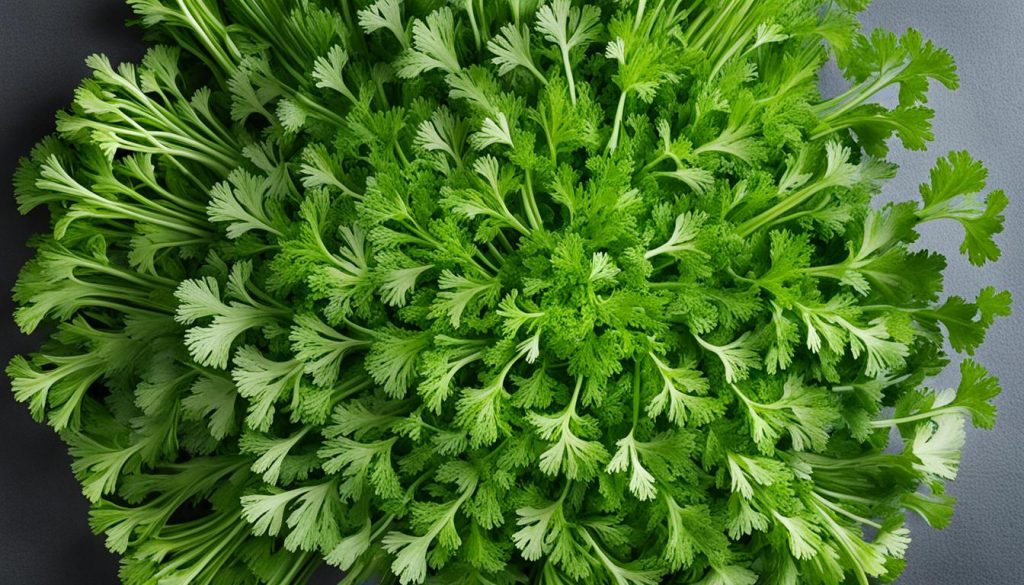
Growing and Harvesting Fresh Parsley
I love growing my own parsley. It’s easy to care for and adds flavor to many dishes. To grow it, I need well-drained soil and full sun. I plant parsley seeds in early spring for a big harvest.
Tips for Planting, Caring, and Extending the Parsley Harvest Season
Looking after parsley is simple. Cutting it often makes it grow more. I cut the leaves to an inch from the ground with scissors or shears. This way, I get more leaves and can harvest parsley into fall or even winter in mild places.
To keep harvesting parsley longer, I plant new seeds every few weeks. This keeps me with fresh leaves. Mulching around the plants also helps keep moisture in and stops weeds. This makes the parsley grow longer.
| Parsley Planting Tips | Parsley Care Essentials | Extending the Parsley Harvest |
|---|---|---|
|
|
|
With these tips, I always have fresh parsley for my meals. By extending the parsley harvest, I can use it in many dishes all year.
Storing Parsley for Maximum Freshness
Keeping fresh parsley is key for any cook. Learn the best ways to store it and your parsley will stay crisp and fragrant. This way, it’s always ready to add flavor to your dishes.
First, take off any rubber bands or ties from the parsley bunch. Then, wash the leaves under cool water. After that, dry them with paper towels to get rid of extra moisture. This keeps the parsley from wilting and losing color too soon.
- For short-term storage, roll the parsley leaves in a clean paper towel and put them in an unsealed zip-top bag in the fridge. This keeps the parsley fresh for up to a week.
- Or, treat parsley like flowers by cutting the stems and putting them in a glass of water. Cover the top with a plastic bag and refrigerate. This method can make your parsley last a few more days.
- To store parsley for longer, freeze chopped leaves. Spread them on a baking sheet and freeze until hard. Then, put them in an airtight container or zip-top bag. Frozen parsley stays tasty for up to 6 months.
Using these easy parsley storage methods, your parsley will stay fresh. It’s perfect for quick meals or big dinner parties.
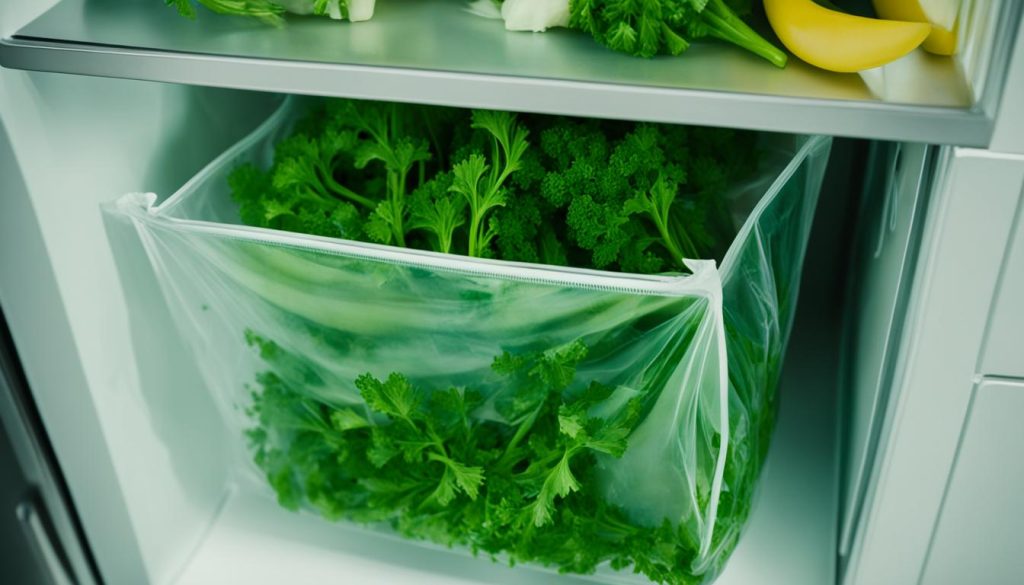
“Proper storage is the key to keeping parsley vibrant and flavorful. With a little care, you can enjoy its bright, herbaceous taste all year round.”
Parsley: More than Just a Garnish
Parsley is more than just a simple garnish. It has a fresh, herbaceous flavor that can make many dishes better. From salads and soups to sauces and stews, parsley adds a light, bright touch. This can turn even simple meals into something special.
Elevating Dishes with Parsley’s Fresh, Herbaceous Flavor
Parsley tastes like a squeeze of lemon but with a deeper herbal flavor. It’s a versatile ingredient that goes beyond just being a garnish. You can use it in many ways to make your dishes stand out.
- Toss parsley into tabbouleh, pesto, and other grain-based dishes for a light, refreshing flavor.
- Add parsley to sauces, dressings, and marinades to brighten the taste.
- Put lots of parsley in soups and stews for a more complex flavor.
Using parsley as a main ingredient opens up new culinary possibilities. It can take your dishes to new heights of flavor.
“Parsley deserves a place as a key ingredient, not just a finishing touch.”
Health Benefits of Parsley
Parsley is more than just a garnish. It’s a superfood full of health benefits. It’s packed with vitamins, minerals, and antioxidants. This makes it a must-have in every kitchen.
Packed with Vitamins, Minerals, and Antioxidants
Parsley is known for its nutrient-rich profile. It’s a great source of vitamin K. Just one tablespoon gives you over 70% of what you need daily.
It also has a lot of vitamins A and C, and antioxidants like lutein and zeaxanthin. These nutrients support your health in many ways.
Parsley is also full of flavone apigenin, which fights cancer. It helps with bone and eye health. So, it’s a superfood you should eat more of.
| Nutrient | Amount in 1 Tbsp Parsley | % of Daily Value |
|---|---|---|
| Vitamin K | 82 mcg | 68% |
| Vitamin A | 169 mcg | 19% |
| Vitamin C | 3.8 mg | 6% |
| Lutein and Zeaxanthin | 573 mcg | N/A |
| Apigenin | 4.5 mg | N/A |
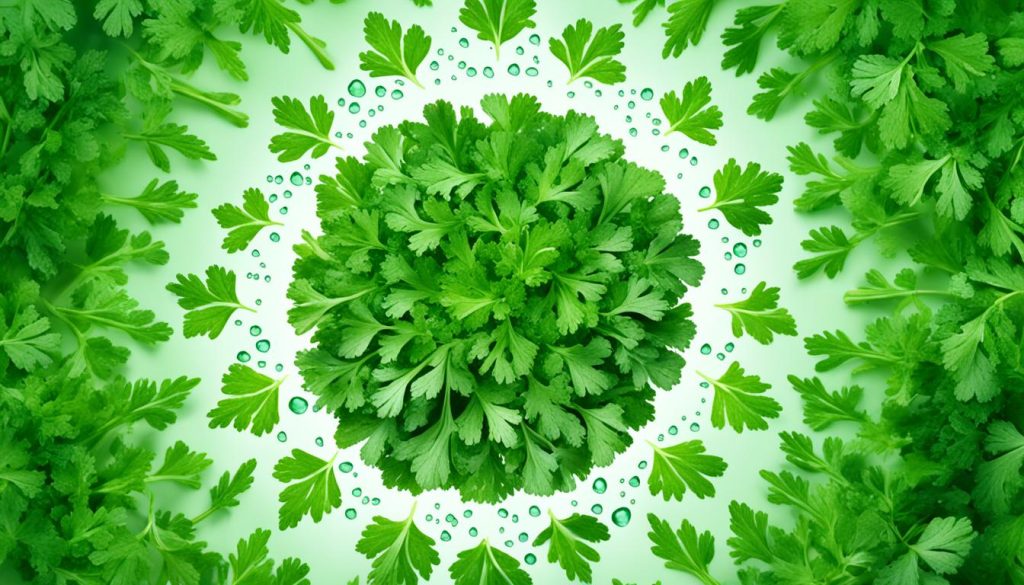
Parsley is a true superfood, packed with essential vitamins, minerals, and antioxidants that offer a wide range of health benefits. From supporting bone health to promoting eye health, this humble herb deserves a prominent place in every kitchen.”
Culinary Uses: From Salads to Sauces
Parsley is more than just an ordinary herb in the kitchen. It brings a fresh, herbaceous flavor to many dishes. This makes it a key ingredient from start to finish.
In salads, parsley adds a burst of flavor and color. It’s perfect in simple green salads or in tabbouleh, balancing the flavors of bulgur and lemon.
Parsley also shines in sauces and dressings. It adds a fresh touch to rich flavors in salsa verde and gremolata. A parsley sauce can make grilled fish or roasted vegetables taste amazing.
Parsley isn’t just for salads and sauces. It can also brighten up soups and stews. Adding parsley at the end of cooking can make even the heaviest soups taste fresh.
Finally, parsley is great as a finishing touch. It can make any dish look and taste better, like a squeeze of lemon or vinegar. Every cook should know the value of parsley.
| Culinary Use | Example Dishes |
|---|---|
| Salads | Green salads, tabbouleh |
| Sauces and Dressings | Salsa verde, gremolata |
| Soups and Stews | Minestrone, beef stew |
| Finishing Herb | Grilled fish, roasted vegetables |
“Parsley is the unsung hero of the herb world, adding a fresh, vibrant touch to so many dishes. It’s time to give this versatile ingredient the respect it deserves.”
Preserving Parsley’s Flavor for Year-Round Use
I love the fresh, herbaceous taste of parsley. But it doesn’t last forever. Luckily, there are ways to keep its flavor all year.
Freezing parsley pesto is one of my top tips. I mix fresh parsley with olive oil, garlic, and Parmesan cheese. Then, I freeze it in small parts. This keeps the fresh taste of parsley and adds flavor to soups and pasta.
Freezing parsley leaves is another great idea. I wash and dry the leaves well. Then, I spread them on a baking sheet and freeze them. After freezing, I put them in a bag or container. This way, I can add fresh parsley to my meals anytime.
Drying parsley is also a good choice for keeping it fresh longer. Dried parsley is handy for marinades, dressings, and roasted veggies. It may not be as fresh as the real thing, but it’s a good alternative.
Choosing any of these methods helps me keep parsley fresh all year. It’s amazing how a little effort can make a big difference in flavor.
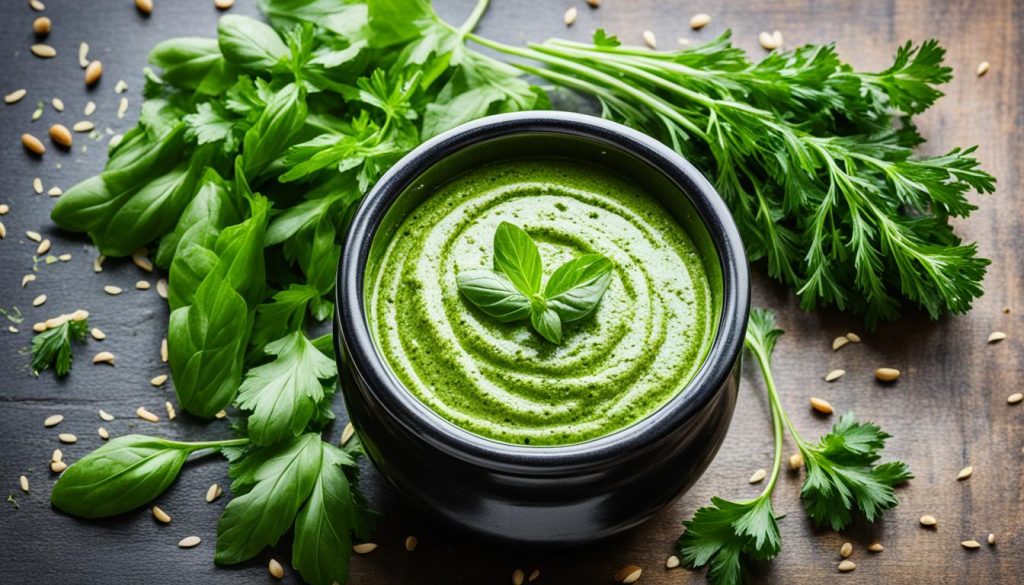
“Parsley is the herb that ties a dish together, adding a fresh, vibrant note to so many of our favorite foods.”
Parsley
Parsley is more than just a garnish. It’s a flavor and nutrition powerhouse. Let’s explore its true value.
Parsley belongs to the Apiaceae family, like dill and fennel. It’s a hardy plant that loves well-drained soil and partial shade. There are two types: flat-leaf and curly-leaf. Both add unique flavors and textures to many recipes.
Culinary Versatility
Parsley’s fresh taste and slightly peppery flavor are great with many dishes. It’s perfect for salads, soups, sauces, and marinades. Its bright taste goes well with proteins, veggies, and grains, making it versatile for both savory and sweet dishes.
Nutritional Powerhouse
Parsley is not just for flavor. It’s full of vitamins and minerals like vitamin K, C, A, folate, and iron. It also has antioxidants that support health. Adding parsley to your meals can boost your nutrition and health.
“Parsley is the unsung hero of the culinary world, offering far more than just a pretty garnish.”
Whether you grow your own or buy it, parsley should be in your kitchen. It can make your favorite dishes better and add nutrition. Parsley is a culinary gem waiting to be discovered.
Respect the Herb: A Fresh Take on Parsley
Parsley is often overlooked but it’s truly special. It adds flavor, nutrients, and versatility to dishes. As a home cook, I’ve learned how parsley can make simple dishes shine.
Parsley is more than just a garnish. It’s a key ingredient in many recipes, like salads, sauces, soups, and stews. Its fresh taste adds a nice contrast to rich foods. Plus, it’s full of vitamins, minerals, and antioxidants.
Let’s use parsley in new ways. Sprinkle it on roasted veggies, mix it into pesto, or add it to cocktails. This herb can change how we see cooking. Let’s give parsley the respect it deserves and explore its many uses.

